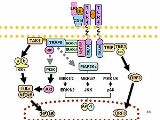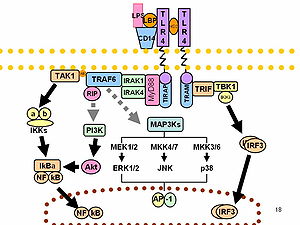
Trif
Encyclopedia
TIR-domain-containing adapter-inducing interferon-β (TRIF) is an adapter in responding to activation of toll-like receptors (TLRs). It mediates the rather delayed cascade of two TLR-associated signaling cascades, where the other one is dependent upon a MyD88
adapter.
Toll-like receptors (TLRs) recognize specific components of microbial invaders and activate an immune response to these pathogens. After these receptors recognize highly-conserved pathogenic patterns, a downstream signaling cascade is activated in order to stimulate the release of inflammatory cytokines and chemokines as well as to upregulate the expression of immune cells. All TLRs have a TIR domain that initiates the signaling cascade through TIR adapters. Adapters are platforms that organize downstream signaling cascades leading to a specific cellular response after exposure to a given pathogen.
is deficient in the liver, indicating organ-specific regulation of signaling pathways. Curiously, there is a lack of redundancy within the TLR4 signaling pathway that leads to microbial evasion of immune response in the host after mutations occur within intermediates of the pathway. Three TRAF
-binding motifs present in the amino terminal region of TRIF are necessary for association with TRAF6
. Destruction of these motifs reduced the activation of NF-κβ, a transcription factor that is also activated by the carboxy-terminal domain of TRIF in the upregulation of cytokines and co-stimulatory immune molecules. This domain recruits receptor-interacting protein (RIP1) and RIP3 through the RIP homotypic interaction motif. Cells deficient for RIP1 gene display attenuated TLR3 activation of NF-κβ, indicating the use of the RIP1 gene in downstream TRIF activation, in contrast to other TLRs that use IRAK protein for the activation of NF-κβ.
The TRIF cascade is a MyD88
-independent signaling pathway associated with TLR3 and TLR4. A second adapter protein identified as TRAM (TRIF-related adaptor molecule) acts as an essential bridge between TRIF and TLR4, acting upstream of the TRIF protein. These TIR domain-containing adapters are differentially recruited to TLRs upon stimulation by pathogenic patterns. The TRIF cascade results in the activation of IRF-3, which then activates interferons α and β, which are essentially for an inflammatory immune response. This pathway also stimulates NF-κB, which upregulates costimulatory molecules CD40, CD80
, and CD86
that in turn activate T-cell production and immune response. Overproduction of these molecules, however, can also lead to organ failure and death. Therefore, regulation of these pathways is crucial. A member of the TIR-domain superfamily, TIR8/SIGIRR is unable to initiate signaling but is able to negatively modulate the TIR-mediated responses. A variety of other regulatory molecules, as well as cooperation between MyD88-dependent and –independent pathways act to ensure an appropriate amount of immune response.

of infectious disease, septic shock
, tumor
growth, and rheumatoid arthritis
all have close ties with TLR signaling pathways, specifically to that of TRIF. Better understanding of the TRIF pathway will be therapeutically useful in the development of vaccines and treatments that can control associated inflammation and antiviral responses. Experiments involving wild-type and TRIF-deficient mice are critical for understanding the coordinated responses of TLR pathways. It is necessary to study the coordinated effects of these pathways in order to understand the complex responses initiated by TRIF.
Myd88
Myeloid differentiation primary response gene is a protein that, in humans, is encoded by the MYD88 gene.-Function:In mice, MyD88 is a universal adapter protein as it is used by all TLRs to activate the transcription factor NF-κB. Mal is necessary to recruit Myd88 to TLR 2 and TLR 4, and MyD88...
adapter.
Toll-like receptors (TLRs) recognize specific components of microbial invaders and activate an immune response to these pathogens. After these receptors recognize highly-conserved pathogenic patterns, a downstream signaling cascade is activated in order to stimulate the release of inflammatory cytokines and chemokines as well as to upregulate the expression of immune cells. All TLRs have a TIR domain that initiates the signaling cascade through TIR adapters. Adapters are platforms that organize downstream signaling cascades leading to a specific cellular response after exposure to a given pathogen.
Structure
TRIF is primarily active in the spleen and is often regulated when MyD88Myd88
Myeloid differentiation primary response gene is a protein that, in humans, is encoded by the MYD88 gene.-Function:In mice, MyD88 is a universal adapter protein as it is used by all TLRs to activate the transcription factor NF-κB. Mal is necessary to recruit Myd88 to TLR 2 and TLR 4, and MyD88...
is deficient in the liver, indicating organ-specific regulation of signaling pathways. Curiously, there is a lack of redundancy within the TLR4 signaling pathway that leads to microbial evasion of immune response in the host after mutations occur within intermediates of the pathway. Three TRAF
TRAF
TNF receptor associated factors also known as TRAFs are a family of proteins primarily involved in the regulation of inflammation, antiviral responses and apoptosis....
-binding motifs present in the amino terminal region of TRIF are necessary for association with TRAF6
TRAF6
TRAF6 is a TRAF human protein.-Interactions:TRAF6 has been shown to interact with SDCBP, IRAK2, IRAK1, MAP3K7IP2, MAP3K7IP1, TNFRSF13B, FHL2, CD40, IKBKG, RANK, HSPB2, UBE2N, SIGIRR, TAX1BP1, ASK1, PPP4C, TNFAIP3, Sequestosome 1, MAP3K7 and Ubiquitin C....
. Destruction of these motifs reduced the activation of NF-κβ, a transcription factor that is also activated by the carboxy-terminal domain of TRIF in the upregulation of cytokines and co-stimulatory immune molecules. This domain recruits receptor-interacting protein (RIP1) and RIP3 through the RIP homotypic interaction motif. Cells deficient for RIP1 gene display attenuated TLR3 activation of NF-κβ, indicating the use of the RIP1 gene in downstream TRIF activation, in contrast to other TLRs that use IRAK protein for the activation of NF-κβ.
Function
The TRIF cascade is a MyD88
Myd88
Myeloid differentiation primary response gene is a protein that, in humans, is encoded by the MYD88 gene.-Function:In mice, MyD88 is a universal adapter protein as it is used by all TLRs to activate the transcription factor NF-κB. Mal is necessary to recruit Myd88 to TLR 2 and TLR 4, and MyD88...
-independent signaling pathway associated with TLR3 and TLR4. A second adapter protein identified as TRAM (TRIF-related adaptor molecule) acts as an essential bridge between TRIF and TLR4, acting upstream of the TRIF protein. These TIR domain-containing adapters are differentially recruited to TLRs upon stimulation by pathogenic patterns. The TRIF cascade results in the activation of IRF-3, which then activates interferons α and β, which are essentially for an inflammatory immune response. This pathway also stimulates NF-κB, which upregulates costimulatory molecules CD40, CD80
CD80
Cluster of Differentiation 80 is a protein found on activated B cells and monocytes that provides a costimulatory signal necessary for T cell activation and survival...
, and CD86
CD86
Cluster of Differentiation 86 is a protein expressed on antigen-presenting cells that provides costimulatory signals necessary for T cell activation and survival...
that in turn activate T-cell production and immune response. Overproduction of these molecules, however, can also lead to organ failure and death. Therefore, regulation of these pathways is crucial. A member of the TIR-domain superfamily, TIR8/SIGIRR is unable to initiate signaling but is able to negatively modulate the TIR-mediated responses. A variety of other regulatory molecules, as well as cooperation between MyD88-dependent and –independent pathways act to ensure an appropriate amount of immune response.

Areas of research
Investigations into the function of TRIF are of great significance to various fields of biomedical research. The pathogenesisPathogenesis
The pathogenesis of a disease is the mechanism by which the disease is caused. The term can also be used to describe the origin and development of the disease and whether it is acute, chronic or recurrent...
of infectious disease, septic shock
Septic shock
Septic shock is a medical emergency caused by decreased tissue perfusion and oxygen delivery as a result of severe infection and sepsis, though the microbe may be systemic or localized to a particular site. It can cause multiple organ dysfunction syndrome and death...
, tumor
Tumor
A tumor or tumour is commonly used as a synonym for a neoplasm that appears enlarged in size. Tumor is not synonymous with cancer...
growth, and rheumatoid arthritis
Rheumatoid arthritis
Rheumatoid arthritis is a chronic, systemic inflammatory disorder that may affect many tissues and organs, but principally attacks synovial joints. The process produces an inflammatory response of the synovium secondary to hyperplasia of synovial cells, excess synovial fluid, and the development...
all have close ties with TLR signaling pathways, specifically to that of TRIF. Better understanding of the TRIF pathway will be therapeutically useful in the development of vaccines and treatments that can control associated inflammation and antiviral responses. Experiments involving wild-type and TRIF-deficient mice are critical for understanding the coordinated responses of TLR pathways. It is necessary to study the coordinated effects of these pathways in order to understand the complex responses initiated by TRIF.
External links
- Toll-like receptor signaling pathway - Reference pathway (KO) from the KEGG website.

